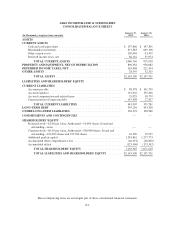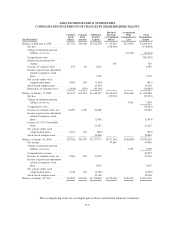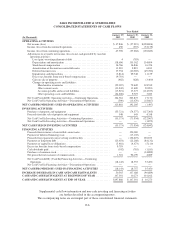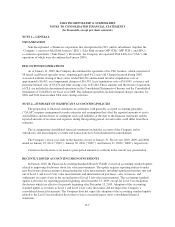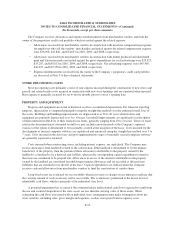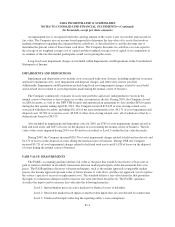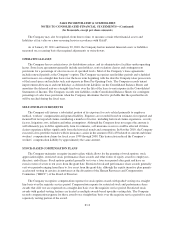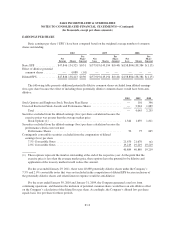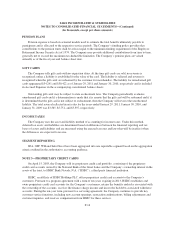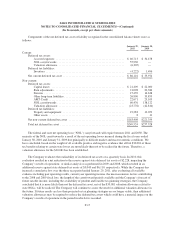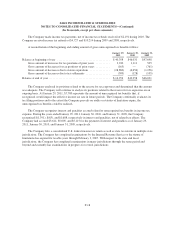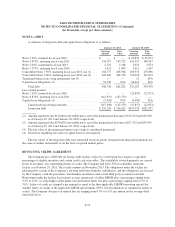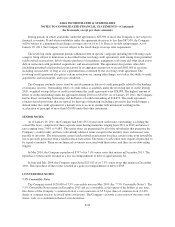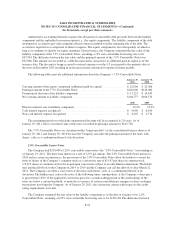Saks Fifth Avenue 2010 Annual Report Download - page 64
Download and view the complete annual report
Please find page 64 of the 2010 Saks Fifth Avenue annual report below. You can navigate through the pages in the report by either clicking on the pages listed below, or by using the keyword search tool below to find specific information within the annual report.SAKS INCORPORATED & SUBSIDIARIES
NOTES TO CONSOLIDATED FINANCIAL STATEMENTS—(Continued)
(In thousands, except per share amounts)
PENSION PLANS
Pension expense is based on actuarial models used to estimate the total benefits ultimately payable to
participants and is allocated to the respective service periods. The Company’s funding policy provides that
contributions to the pension trusts shall be at least equal to the minimum funding requirement of the Employee
Retirement Income Security Act of 1974. The Company may provide additional contributions from time to time,
generally not to exceed the maximum tax-deductible limitation. The Company’s pension plans are valued
annually as of the fiscal year-end balance sheet date.
GIFT CARDS
The Company sells gift cards with no expiration dates. At the time gift cards are sold, no revenue is
recognized; rather a liability is established for the value of the card. The liability is relieved and revenue is
recognized when the gift cards are redeemed by the customer for merchandise. The liability for unredeemed gift
cards aggregated $34,241 and $30,422 as of January 29, 2011 and January 30, 2010, respectively and is included
in Accrued Expenses in the accompanying consolidated balance sheets.
Outstanding gift cards may be subject to state escheatment laws. The Company periodically evaluates
unredeemed gift cards and if a determination is made that it is remote that the gift card will be redeemed and if it
is determined that the gift card is not subject to escheatment, then the Company will reverse the unredeemed
liability. The total reversal reflected in net sales for the years ended January 29, 2011, January 30, 2010, and
January 31, 2009 was $3,565, $5,751, and $5,397, respectively.
INCOME TAXES
The Company uses the asset and liability method of accounting for income taxes. Under this method,
deferred tax assets and liabilities are determined based on differences between the financial reporting and tax
bases of assets and liabilities and are measured using the enacted tax rates and laws that will be in effect when
the differences are expected to reverse.
SEGMENT REPORTING
SFA, OFF 5TH and Saks Direct have been aggregated into one reportable segment based on the aggregation
criteria outlined in the authoritative accounting guidance.
NOTE 3—PROPRIETARY CREDIT CARDS
On April 15, 2003, the Company sold its proprietary credit card portfolio, consisting of the proprietary
credit card accounts owned by the National Bank of the Great Lakes and the Company’s ownership interest in the
assets of the trust, to HSBC Bank Nevada, N.A. (“HSBC”), a third party financial institution.
HSBC, an affiliate of HSBC Holdings PLC, offers proprietary credit card accounts to the Company’s
customers. Pursuant to a program agreement with a term of ten years expiring in 2013, HSBC establishes and
owns proprietary credit card accounts for the Company’s customers, retains the benefits and risks associated with
the ownership of the accounts, receives the finance charge income and incurs the bad debts associated with those
accounts. During the ten-year term, pursuant to a servicing agreement, the Company continues to provide key
customer service functions, including new account openings, transaction authorizations, billing adjustments and
customer inquiries, and receives compensation from HSBC for these services.
F-14


